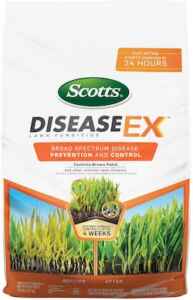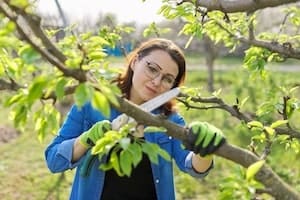Mushrooms can be a nuisance to lawn owners, especially if you have children or pets that love to play outside. Not only do they ruin the aesthetic appeal of your lawn, but some mushrooms can also be toxic if ingested. Fortunately, keeping mushrooms out of your lawn is not as complicated as you might think. In this article, we will share with you effective ways to prevent and get rid of mushrooms in your lawn so you can have a healthy and beautiful outdoor space.
Why Do Mushrooms Grow on Lawns?
Before we dive into the solutions, it is important to understand why mushrooms grow on lawns in the first place. Mushrooms are fungi, and they thrive in damp, dark environments. Here are some common reasons why mushrooms may be growing on your lawn:
- Overwatering: Too much watering can create a moist environment that is conducive to mushroom growth.
- Poor Drainage: If your lawn does not drain properly, water can accumulate and create a damp environment that encourages mushroom growth.
- Decaying Roots: If there are decaying roots or organic matter beneath your lawn’s surface, mushrooms can grow and thrive.
- Shady Areas: Mushrooms love shade, so if your lawn has areas that do not get enough sunlight, they may be prone to mushroom growth.
How do I Keep Mushrooms Out of My Lawn?
Now that we understand why mushrooms grow on lawns let’s explore some effective ways to keep them out of your lawn.
Reduce Watering
Reducing watering is one of the easiest ways to prevent mushroom growth. Water your lawn only when necessary and ensure that you are not overwatering. This will help to keep the soil dry and less conducive to mushroom growth.
Improve Drainage
Poor drainage can create an environment that is conducive to mushroom growth. You can improve your lawn’s drainage by:
- Aerating your lawn: This will help to loosen compacted soil and improve water absorption.
- Adding compost: Compost can improve the soil structure and help with water absorption.
- Installing drainage: If your lawn has poor drainage, you may want to consider installing a drainage system to redirect excess water away from your lawn.
Remove Decaying Roots and Organic Matter
Mushrooms thrive in soil that contains decaying roots and organic matter. To prevent mushroom growth, remove any dead roots or organic matter from your lawn’s surface.
Fungicides
If you have a severe mushroom problem, you may want to consider using a fungicide. Fungicides are chemical treatments that can kill fungi, including mushrooms. However, it is important to use fungicides correctly and follow the instructions on the label to avoid damaging your lawn or harming the environment.
Aerate your lawn
Aerating your lawn involves creating small holes in the soil to allow air, water, and nutrients to reach the roots. This can help reduce the amount of organic matter in your soil, which can in turn reduce the growth of mushrooms.
Use a de-thatcher
A de-thatcher is a machine that can remove dead grass, leaves, and other organic material from your lawn. By removing this material, you can help reduce the amount of organic matter in your soil, which can prevent mushrooms from growing.
Use vinegar
Vinegar is a natural fungicide that can help kill mushrooms and prevent their growth. Mix one part vinegar with one part water and spray the solution onto the mushrooms. However, be careful not to use too much vinegar as it can damage your lawn.
Use baking soda
Baking soda is another natural fungicide that can help kill mushrooms. Mix two tablespoons of baking soda with one gallon of water and spray the solution onto the mushrooms. However, like vinegar, be careful not to use too much baking soda as it can damage your lawn.
Increase Sunlight
Mushrooms love shade, so increasing sunlight exposure to your lawn can help to prevent their growth. Trim any trees or bushes that may be blocking sunlight from reaching your lawn.
Use cornmeal
Cornmeal is a natural fungicide that can help prevent mushrooms from growing. Spread a thin layer of cornmeal over your lawn, focusing on the areas where mushrooms are growing. The cornmeal will release a natural fungus that can help kill the mushrooms.
Remember, while these strategies can be effective, it’s important to also address the underlying issues that are causing the mushrooms to grow in the first place. By improving drainage, reducing watering, and removing decaying roots and organic matter, you can create a healthy, mushroom-free lawn.
FAQs
Q: Are mushrooms harmful to pets?
A: Yes, some mushrooms can be toxic to pets if ingested. Keep an eye on your pets and remove any mushrooms that may be growing on your lawn.
Q: Can mushrooms damage my lawn?
A: In most cases, mushrooms do not damage lawns. However, some species of mushrooms can cause root rot, which can damage the grass and lead to thinning.
Q: Should I pull out mushrooms from my lawn?
A: Yes, you can pull out mushrooms from your lawn. However, it is important to wear gloves and handle them with care as some species can be toxic. Additionally, pulling out mushrooms does not eliminate the root system, so they may grow back.
Q: Can mushrooms grow on artificial turf?
A: No, mushrooms do not grow on artificial turf as it is not made of organic material.
Q: Do mushrooms cause brown spots?
A: Brown spots can actually be caused by fungi as well! Brown spots typically appear when your lawn is oversaturated, often due to excessive watering. There are a few other common culprits that cause brown spots in your yard such as pet waste, grubs, foot traffic, and even bad mowing techniques.
Conclusion
Mushrooms can be a nuisance to lawn owners, but with the right strategies, you can keep them out of your lawn. Remember to reduce watering, improve drainage, remove decaying roots and organic matter, increase sunlight exposure, and consider using fungicides as a last resort. If you have pets or children, keep an eye on them and remove any mushrooms that may be growing on your lawn. With these tips, you can enjoy a healthy, lush lawn without any unwanted mushrooms.



